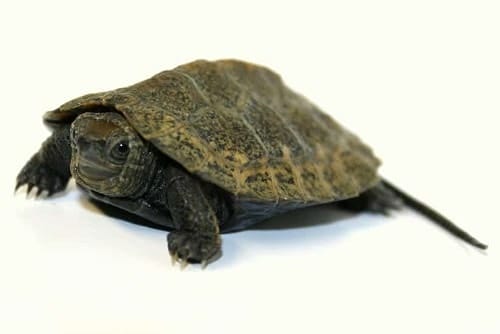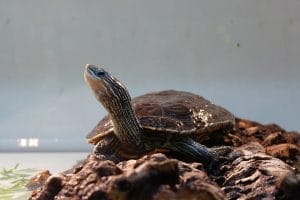Mauremys japonica (Japanese Pond Turtle)
Home > Turtle Database > Mauremys japonica (Japanese Pond Turtle)

Mauremys japonica, commonly known as the Japanese Pond Turtle, is a freshwater turtle species native to East Asia. Known for its distinctive shell patterns and adaptability to various aquatic environments, it plays a significant role in local ecosystems. This species is subject to conservation efforts due to habitat loss and other threats.
Native To These Regions
JapanNative Turtle Species Map – Find Turtles by Region
Scientific Classification
- Kingdom: Animalia
- Phylum: Chordata
- Class: Reptilia
- Order: Testudines
- Family: Geoemydidae
- Genus: Mauremys
- Species: Mauremys japonica
Common Names
- Japanese Pond Turtle
- Japanese Marsh Turtle
- Nippon Pond Turtle
This Hilarious Turtle Book Might Know Your Pet Better Than You Do
Let’s be real—most turtle care guides feel like reading a textbook written by a sleep-deprived zookeeper.
This one’s not that.
Told from the snarky point of view of a grumpy, judgmental turtle, 21 Turtle Truths You’ll Never Read in a Care Guide is packed with sarcasm, sass, and surprisingly useful insights.
And hey—you don’t have to commit to the whole thing just yet.
Grab 2 free truths from the ebook and get a taste of what your turtle really thinks about your setup, your food choices, and that weird plastic palm tree.
It’s funny, it’s honest, and if you’ve ever owned a turtle who glares at you like you’re the problem—you’ll feel seen.
Identification
Description
The Japanese Pond Turtle has a moderately domed carapace typically ranging from 15 to 20 centimeters in length. Its shell features intricate patterns of dark and light markings, which can vary among individuals. The skin is generally dark with yellow or orange markings on the head and limbs. The species possesses a distinctive hinge on the plastron, allowing it to close its shell tightly.
Sexual Dimorphism
Males are usually smaller than females and exhibit longer, thicker tails with a visible cloacal protrusion. They often have more vibrant coloration compared to females. Females have broader and flatter shells to accommodate egg laying and lack the pronounced tail features seen in males.
Check more turtles from the Mauremys genus
Native Origin and Distribution
Geographical Range
Mauremys japonica is primarily found in Japan, including the main islands of Honshu, Kyushu, and Shikoku. Additionally, its range extends to parts of China and Korea, where it inhabits various freshwater ecosystems.
Preferred Habitat
This species thrives in slow-moving or stagnant freshwater bodies such as ponds, marshes, rice paddies, and slow streams. It prefers areas with abundant aquatic vegetation, which provide both food sources and shelter from predators. Japanese Pond Turtles are also adaptable to urban environments, often found in garden ponds and parks.
Behavior
Feeding Habits
Japanese Pond Turtles are omnivorous, feeding on a diet that includes aquatic plants, insects, small fish, and invertebrates. They forage both underwater and on land, using their strong jaws to crush hard-shelled prey and nibble on vegetation.
Predators
Natural predators of Mauremys japonica include larger fish, birds of prey, raccoons, and other carnivorous mammals. Juvenile turtles are particularly vulnerable to predation. Additionally, human activities such as collection for the pet trade and habitat destruction pose significant threats.
Reproduction
Breeding Season
The breeding season for the Japanese Pond Turtle typically occurs in the spring, coinciding with warmer temperatures and increased food availability. Males engage in courtship behaviors to attract females, including head bobbing and tail movements.
Reproductive Method
Females lay clutches of 5 to 15 eggs in sandy or soft soil near water bodies. The incubation period lasts several weeks, depending on environmental conditions. Hatchlings emerge fully independent and begin foraging immediately to survive in their aquatic habitats.
Conservation
Extinction Status
Mauremys japonica is currently listed as Near Threatened by the IUCN Red List. However, certain local populations may be at risk due to specific threats.
Threats
Major threats include habitat loss due to urbanization and agricultural expansion, pollution of freshwater habitats, and over-collection for the pet trade and traditional medicine. Invasive species also compete for resources and can alter the ecological balance of their habitats.
Conservation Measures
Conservation efforts focus on habitat preservation and restoration, implementing protective legislation to regulate collection, and promoting public awareness about the species’ ecological importance. Captive breeding programs and research initiatives aim to support population stability and genetic diversity.
Economic Importance
Japanese Pond Turtles hold economic value in the pet trade, contributing to local economies. They are also important for ecotourism, attracting nature enthusiasts and researchers. Additionally, their role in controlling insect populations and maintaining healthy aquatic ecosystems provides indirect economic benefits.
Interesting Facts
- The hinge on the plastron allows Japanese Pond Turtles to close their shells tightly, offering protection from predators and environmental threats.
- They are known to hibernate during the colder months, burrowing into mud or sediment at the bottom of water bodies to survive low temperatures.
- Mauremys japonica exhibits temperature-dependent sex determination, where the incubation temperature of eggs influences the sex of the hatchlings.
- These turtles have a lifespan of up to 50 years in the wild, showcasing their resilience and adaptability to various environments.

About Author
Muntaseer Rahman started keeping pet turtles back in 2013. He also owns the largest Turtle & Tortoise Facebook community in Bangladesh. These days he is mostly active on Facebook.














